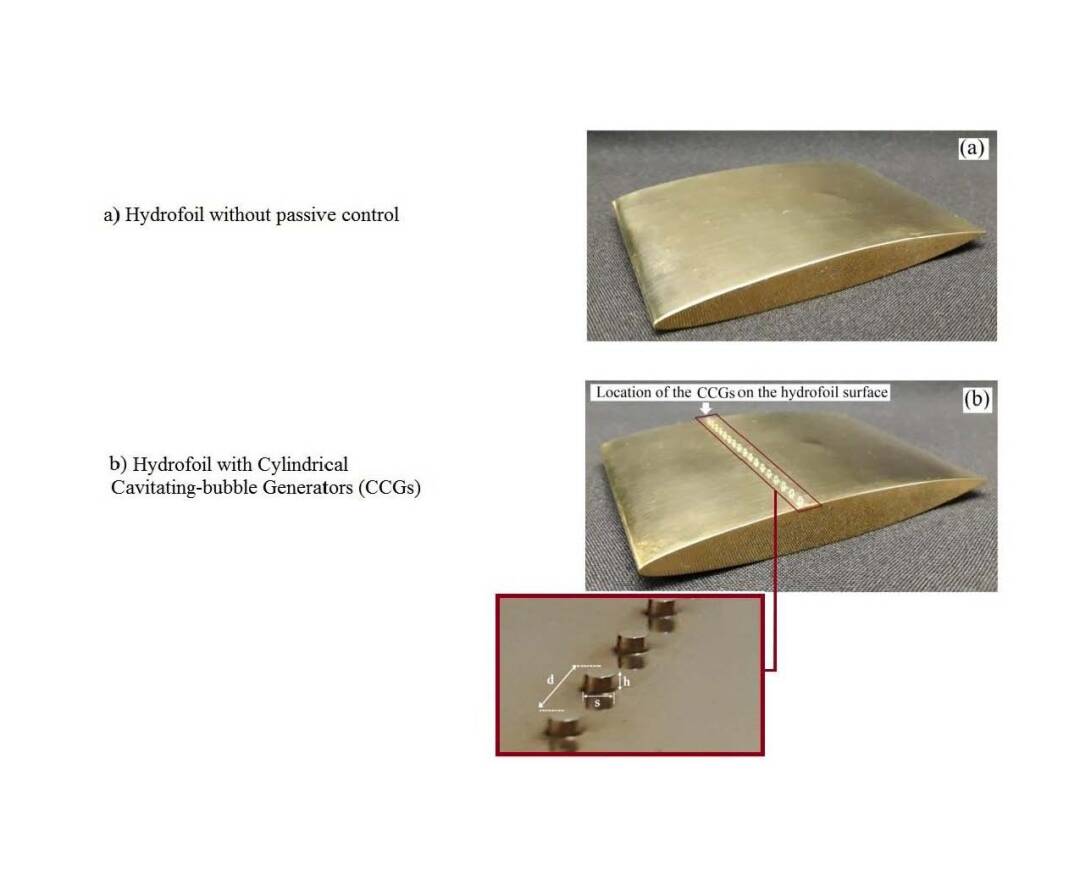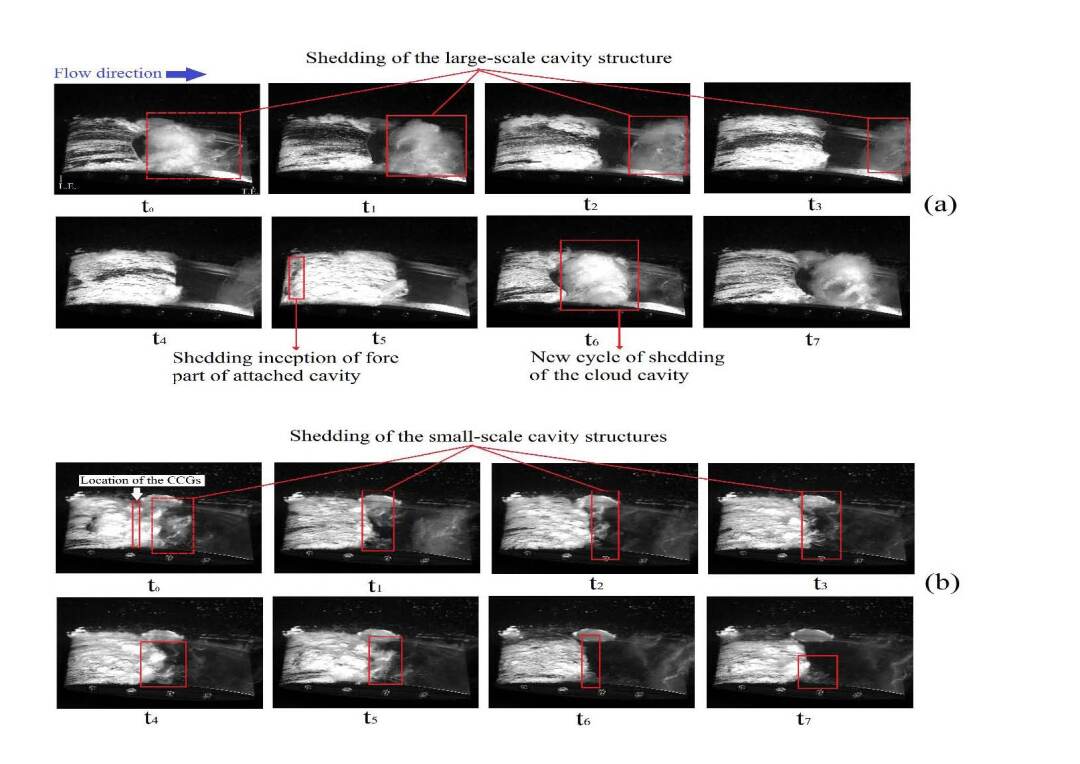Cavitation Control in Marine Engineering and Hydraulic Systems (CCMEHS)
Involved scientists
Prof. Dr. Khodayar Javadi
Dr.-Ing. Ebrahim Kadivar
Mikhail V. Timoshevskiy M. Sc.
Konstantin S. Pervunin M. Sc.
Prof. Dr.-Ing. Bettar Ould el Moctar
Project description
Cavitation is a physical phenomenon which consists of evaporation, bubble formation and collapse and plays an important role in many technical fields. Cavitation appears in ship technology due to its erosive effect on the ship’s rudder and propeller as a result of the collapse of cavitation bubbles near the wall surface. Cavitation can cause structural vibrations, noise emissions, and hydrodynamic efficiency reduction in the maritime sector and in hydraulic machinery systems. Measures to reduce or avoid undesirable cavitation-related consequences may importantly contribute to a better economic operation of ships and hydraulic machinery. This project deals with developing efficient passive flow control methods to control and suppress the deleterious effects of cavitation in different regimes.
For this aim, a wedge-type miniature vortex generator so-called Cavitating-bubble Generator (CG) was developed and cylindrical-type miniature vortex generators so-called Cylindrical Cavitating-bubble Generators (CCGs) was proposed to control the cavitation and to stabilize the cavitation-induced instabilities. In this work, experimental investigations of these two cavitation passive control measures under different cavitation conditions such as cavitation inception, quasi-steady partial cavitation, unsteady cloud cavitation and cavitation surge regimes were performed. First, a high-speed visualization of cavitation around two test cases without cavitation control was performed to analyze the cavitation dynamics. Second, a particle image velocity technique was applied to measure the mean flow velocity profiles around the surface and in the wake region.
Third, a hydroacoustic measurement was carried out to record local pressure pulsations in the wake region of the test cases. Then, the effects of the passive flow control methods on the qualitative parameters such as cavity structures in different cavitating regimes were studied by means of high-speed imaging. Finally, the effects of the cavitation control on the quantitative parameters such as pressure pulsations, velocity profiles and shedding frequency were analyzed and compared with the test cases without cavitation control. In addition, numerical investigations of unsteady cavitating flows were performed to study the effects of the cavitation control in details. First, unsteady cavitating flows around the test cases without cavitation control were computed. For modelling of the cavitating flows, an Euler-Euler method with volume of fluid method was used. Further on, a Partially-averaged Navier Stokes (PANS) for turbulence modelling was coupled with the cavitation model and implemented to an open source code. Second, the influence of cavitation model parameters such as different nuclei density, nuclei radius and effect of turbulence model coefficient on the dynamics of unsteady cloud cavitation were analyzed.
The numerical results were validated with the experimental data obtained in this work and the experimental data from a benchmark study. Finally, the effects of different passive cavitation control methods on the qualitative and quantitative parameters of cavitation were analyzed and compared with the test cases without cavitation control. Fair qualitative and quantitative agreements were obtained with the experimental data. The results revealed that the implemented cavitation control methods are effective methods to mitigate the cavitation regions and to suppress the unsteady behavior of the cavitation. Overall, this work presents results towards the investigation of cavitation control and the finding may be used to further develop in scientific and industrial applications in future works.
Sample results

Fig. 1: Photographs of the CAV2003 hydrofoils: (a) without cavitation control and (b) with Cylindrical Cavitating-bubble Generators (CCGs) mounted on the suction side. Symbols s, h, and d are the CCGs diameter, height, and distance between them, respectively (Kadivar et al., 2020).

Fig. 2: Sequence of snapshots (angle view) of unsteady cloud cavitation evolution during one typical oscillation cycle over the hydrofoil surface: (a) without and (b) with CCGs. The Reynolds number is Re = 1.4x106, the cavitation number is σ = 1.3, the attack angle is α = 7° (σ/2α = 5.3). The shedding frequencies for the original and modified hydrofoil are f = 74 and 78 Hz, respectively (Kadivar et al., 2019b).
Publications
- Kadivar, E., Timoshevskiy, M.V., Nichik, Yu., el Moctar, O., Schellin, T.E., Pervunin, K.S.
“Control of unsteady partial and cloud cavitations in marine engineering and hydraulic systems”,
Physics of Fluids, Volume 32, pp. 052108, 2020. - Kadivar, E., Timoshevskiy, M.V., Pervunin, K.S., el Moctar, O.
“Cavitation control using Cylindrical Cavitating-bubble Generators (CCGs): Experiments on a benchmark CAV2003 hydrofoil”,
International Journal of Multiphase Flow, Volume 125, pp. 103186, 2020. - Kadivar, E., Timoshevskiy, M.V. , Pervunin, K.S., el Moctar, O.
“Experimental and numerical study of the cavitation surge passive control around a semi-circular leadingedge flat plate”,
Journal of Marine Science and Technology Volume 25, 1010-1023, 2019. - Kadivar, E., Timoshevskiy, M.V. , Pervunin, K.S., el Moctar, O.
“Experimental investigation of the passive control of unsteady cloud cavitation using miniature vortex generators (MVGs)”,
IOP Conference Series: Earth and Environmental Science, Volume 405. pp. 012002, 2019. - Kadivar, E., el Moctar, O., Javadi, K.
“Stabilization of cloud cavitation instabilities using Cylindrical Cavitating-bubble Generators (CCGs)”,
International Journal of Multiphase Flow, Volume 115, pp. 108-125, 2019. - Kadivar, E. and el Moctar, O.
“Boundary layer instability control in the unsteady cloud cavitating flow”,
Journal of IOP Conference Series Earth and Environmental Science, Volume 240, 062061, 2019. - Kadivar, E., el Moctar, O., Javadi, K.
“Investigation of the effect of cavitation passive control on the dynamics of unsteady cloud cavitation”,
Journal of Applied Mathematical Modelling, Volume 64, pp 333-356, 2018. - Kadivar, E., Timoshevskiy, M.V., Pervunin, K.S., el Moctar, O.
“Experimental study of cloud cavitation control using cavitating-bubble generator (CG)”,
14th International Conference on Hydrodynamics, Rome, Italy, Abstract Accepted, 2020. - Kadivar, E., Timoshevskiy, M.V., Pervunin, K.S., el Moctar, O.
“Experimental investigation of the passive control of unsteady cloud cavitation using miniature vortex generators (MVGs)”,
IAHR International Workshop on Cavitation and Dynamic Problems in Hydraulic Machinery and Systems, Stuttgart, Germany, 2019. - Kadivar, E. and el Moctar, O.
“Boundary layer instability control in the unsteady partial cavitation regime using Cavitationg bubble Generators (CGs)”,
Workshop on Cavitation Exploitation, September 2018, Ljubljana, Slovenia. - Kadivar, E. and el Moctar, O.
“The investigation of cloud cavitation passive control around a hydrofoil using Cavitating-bubble Generators (CGs)”,
The 10th International Symposium on Cavitation (CAV2018), Baltimore, USA, 2018. - Kadivar, E. and el Moctar, O.
“Boundary layer instability control in the unsteady cloud cavitating flow”,
29th IAHR Symposium on Hydraulic Machinery and Systems, Kyoto, Japan, 2018.
Project duration: January 2017 - January 2020Funding
- University of Duisburg-Essen,
- Ministry of Science and Higher Education of the Russian Federation,
- Russian Foundation for Basic Research (RFBR)
Project partner
-
Kutateladze Institute of Thermophysics (Russian Academy of Sciences),
-
Sharif Universty of Technology

